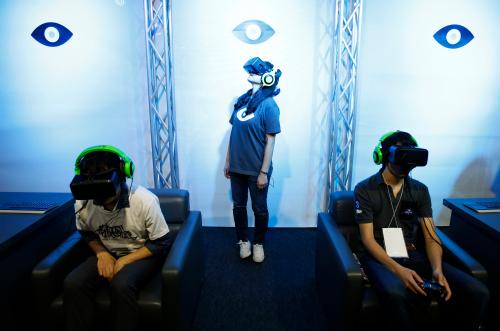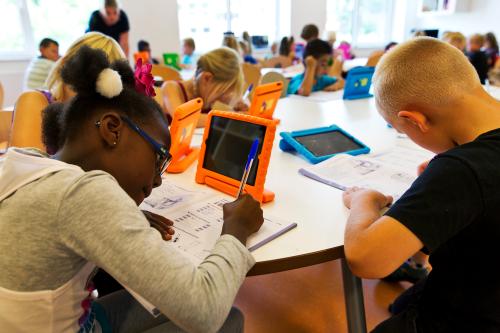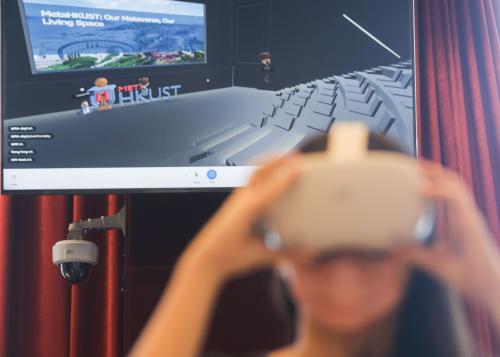This post originally appeared on Brookings’ TechTank blog.
A new back-to-school ritual seems to have taken root in technology circles, as each fall we speculate on whether (and how) education technology will transform the traditional classroom experience. I’m going to join the melee by weighing in on virtual reality’s potential. Despite a number of recent virtual reality (VR) developments, the 2016-17 school year is unlikely to be the time when VR becomes ubiquitous in classrooms across America. I’ll discuss the reasons why and reflect on the VR industry’s potential to break into the education sector.
Several major players in the technology and education sectors are pursuing VR applications for the classroom, reigniting interest in its potential as an educational tool. Facebook acquired Oculus Rift in 2014, sparking speculation about possible educational applications. In 2014, Google introduced Google Cardboard, a low-cost ($10-15), low-tech piece of equipment that creates an immersive experience using, well, cardboard (and a smartphone). The internet giant has also developed the Google Expeditions app, which uses Google Cardboard to create VR field trips where teachers (“guides”) can take their students (“explorers”) on educational adventures. This summer, one of the major education publishers, Houghton Mifflin Harcourt (HMH), partnered with Google to create field trips on the Expeditions app aligned to HMH science and social studies curricula, complete with teacher guides, student activities, and lesson plans.
BARRIERS TO ADOPTION
So why am I pessimistic about whether 2016-17 will be the school year VR revolutionizes K-12 education? The first reason is perhaps the most obvious: cost. Oculus Rift headsets cost $600, which suggests its use in classrooms might be limited to free distribution by Facebook, at least until there’s enough educational content (which it currently lacks) to help districts justify this significant cost. While Google Cardboard itself is inexpensive, Best Buy advertises a Google Expeditions Kit for thirty students at $9,999. While cheaper per student ($333) than Oculus, this cost is still likely prohibitively expensive for many public schools, and large-scale investment in this tool seems unlikely absent concrete evidence that VR field trips improve student learning beyond what could otherwise be accomplished in the classroom.
The second barrier that makes an impending VR revolution unlikely is technological literacy. A 2014 RAND report defines technological literacy as “the ability to use computer-based devices, software, and networks”, where “use” refers not only to operating the relevant devices, but also to “advanced abilities to learn, analyze, explore”. Similar to gaps that open up early on in a child’s life in terms of word acquisition, on average, students from low-income households are at a disadvantage in terms of technological literacy. Low-income families on average have fewer, older, and less portable devices, and students from low-income backgrounds are more likely to use the internet for entertainment and social purposes rather than education.[1] Teachers and administrators, particularly those serving students whose technological literacy lags behind those of their wealthier peers, may be hesitant to invest in VR if it seems unlikely that this technology will enhance their students’ learning.
Third, although a number of VR products are on the market, the VR industry remains immature. Michael B. Horn, co-founder of the Clayton Christenson Institute for Disruptive Innovation, argues that immature industries benefit from an initial stage of development in which all aspects of production are integrated. Once the various components are functioning smoothly, “modular products” can be sold and used individually. Horn suggests that various “edtech” innovations would benefit from concentrated development in an integrated environment—otherwise, individual products may hit the market but will not function smoothly in classrooms and schools.
Without accompanying professional development or alignment to state content standards, teachers lack the tools to integrate VR into their daily classroom routines. While Google Expeditions takes a step in the right direction in its partnership with HMH, as mentioned above, the cost of this program remains a barrier to widespread implementation. In other words, the VR products currently on offer are, in large part, modular components that do not fit very well into the existing system.
WHAT COMES NEXT?
If we do not want to abandon the promise of VR, what comes next? One possibility is that charter networks or private schools may serve as incubators for the VR industry in education (Horn offers a template for this approach, suggesting that alternative school networks may provide the right environment for “personalized learning” technologies to develop). Schools that enjoy autonomy from the traditional education governance structure and, in turn, have more control over many aspects of students’ educational experience may offer an ideal environment to develop VR products that could eventually be incorporated into classrooms more broadly. Charter networks with track records of success that are comparable to traditional public school settings may be potential candidates. Intensive development within such a network may help VR developers refine programs that are designed for traditional classroom environments and are tailored to the demands on students, teachers, and administrators.
Indeed, passage of the Every Student Succeeds Act in December 2015 means that many states are currently in transition, revising accountability systems, standards, curricula, and testing. This period of change may provide more opportunities than usual for the VR industry to work with policy makers and teachers to develop products designed for classroom use. Ultimately, it seems unlikely that VR will burst onto the scene during the 2016-17 school year, but it may be not too far off on the horizon. As with almost every other change in the U.S. education system, if it happens at all, VR integration into classrooms will happen gradually.
Facebook and Google are donors to the Brookings Institution. The findings, interpretations, and conclusions posted in this piece are solely those of the authors and not influenced by any donation.
[1] Potentially compounding this issue, only 14 percent of low-income schools meet the Department of Education’s gold standard for broadband internet access, compared to 39 percent of affluent schools.







Commentary
Is virtual reality ready for school?
September 8, 2016